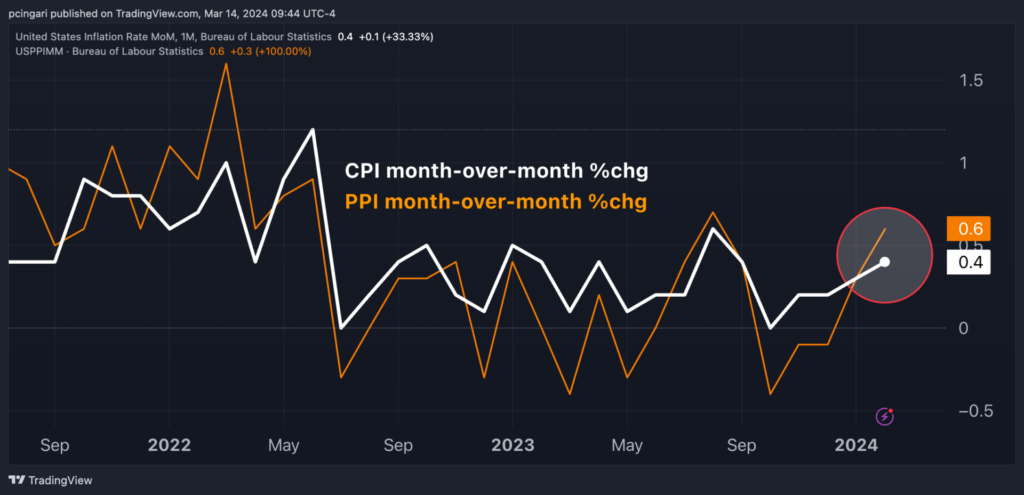Zinger Key Points
- Powell's desire for disinflation confidence meets disappointment with higher-than-expected inflation reports.
- U.S. economy sees heightened price pressures, challenging interest rate gravity.
- Get access to your new suite of high-powered trading tools, including real-time stock ratings, insider trades, and government trading signals.
If Fed Chair Jerome Powell had signaled a desire for increased confidence in inflation descending towards the 2% target, this week’s two inflation reports would undoubtedly have left him disappointed.
In February, price pressures in the U.S. economy surged unexpectedly, challenging the dampening effect of interest rates at their highest over two-decade highs.
The first warning signs emerged last Tuesday with the February Consumer Price Index (CPI) report, which revealed a higher-than-expected increase in the headline index at 3.2% year-on-year (0.4% month-on-month) in February—far above what Powell & Co. had hoped for.
Further adding to concerns, the Producer Price Index (PPI) report unveiled on Thursday confirmed the acceleration of price pressures. The headline PPI rose by 0.6% on the month and by 1.6% on an annual basis, sharply surpassing expectations. A significant portion of the overall PPI increase stemmed from rising gasoline prices, which surged by 6.8% from January.
Read also: Inflation Tops Forecasts In February – ‘I Think Powell Will Be Upset’: 7 Economists React
Chart: US Inflation Surged In February

Investors, preparing for the onset of interest rate cuts by semester’s end, received a sobering reality check as a Fed policy meeting, just days away, looms large.
This meeting is poised to unveil highly anticipated economic projections, offering insight into the preferred interest rate path projected by the Fed.
In December, the Fed indicated a median preference for delivering three rate cuts in 2024, followed by four in 2025.
As the inflation landscape shifts, the likelihood of Powell unfurling banners heralding imminent rate cuts at the press conference next week seems to fade away now.
The looming question now arises: Could these unexpectedly high inflation reports clip the wings of the Fed’s rate cut plans moving forward?
According to Joseph Brusuelas, chief economist at RSM US LLP, “With the economy continuing to outperform and consumers still resilient, the Fed might be far more patient on rate cuts than either its forecast implies or the market has priced in.” The economist expect the Fed to reduce “its policy rate twice, or possibly fewer times, through the end of the year.”
ETF Reacting After Thursday’s Inflation Data
Bonds Tumble
Treasury yields soared across the board, with the yields on the 30-year Treasury note surging by 9 basis points to 4.44%, that’s the highest since late February.
The iShares 20+ Year Treasury Bond ETF TLT tumbled 1.5% by midday Thursday, on track for its sixth straight session in the red, the worst streak since August 2003.
Dollar Rebounds
The U.S. dollar rebounded as the higher-than-expected PPI data fueled demand for the greenback as hedge heading into next week’s Fed meeting.
The Invesco DB USD Index Bullish Fund ETF UUP, which tracks the U.S. dollar index (DXY), was up 0.5%.
Stocks Turn Red
Major U.S. equity indices shifted to the red at the time of publication Thursday.
- The SPDR S&P 500 ETF Trust SPY fell 0.3%
- The tech-heavy Invesco QQQ Trust QQQ was down 0.4%
- Small caps underperformed, with the iShares Russell 2000 ETF IWM tumbling 1.8%
Gold, Bitcoin Fall
Higher Treasury yields and worsening risk sentiment weighed on both gold and Bitcoin BTC/USD
- The SPDR Gold Trust GLD eased 0.6%
- The iShares Bitcoin Trust IBIT fell 4.3%.
Read now: Retail Sales Climb In February As Consumer Activity Picks Up, But Miss Expectations (UPDATED)
Image created using artificial intelligence with Midjourney.
© 2025 Benzinga.com. Benzinga does not provide investment advice. All rights reserved.
Trade confidently with insights and alerts from analyst ratings, free reports and breaking news that affects the stocks you care about.